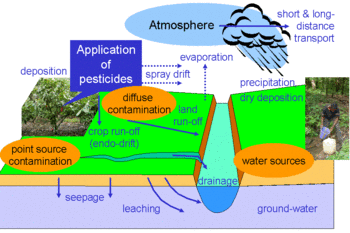Top Guidelines Of Eco Bed Bug Exterminators Dc
Some Ideas on Eco Bed Bug Exterminators Dc You Should Know
Table of Contents8 Easy Facts About Eco Bed Bug Exterminators Dc ExplainedThe Only Guide for Eco Bed Bug Exterminators DcThe Facts About Eco Bed Bug Exterminators Dc UncoveredThe Main Principles Of Eco Bed Bug Exterminators Dc The Ultimate Guide To Eco Bed Bug Exterminators Dc
Due to the fact that chemicals are toxic, they are also possibly dangerous to human beings, animals, other microorganisms, and the setting. Individuals that utilize chemicals or consistently come in call with them must comprehend the family member toxicity, potential health results, and preventative measures to decrease exposure to the products they make use of. Hazard, or danger, of utilizing pesticides is the capacity for injury, or the degree of danger associated with making use of a pesticide under a given set of problems.
Applicators can reduce or virtually eliminate direct exposure-- and thus minimize hazard-- by complying with the label instructions, utilizing personal safety garments and devices (PPE), and dealing with the pesticide effectively. Even more than 95 percent of all chemical direct exposures come from facial direct exposure, primarily to the hands and forearms. By putting on a set of unlined, chemical-resistant handwear covers, this kind of direct exposure can be nearly removed.
The hazardous results that occur from a single direct exposure by any type of course of entry are described "severe effects." The 4 routes of direct exposure are facial (skin), breathing (lungs), oral (mouth), and the eyes. Intense poisoning is identified by taking a look at the facial poisoning, breathing toxicity, and dental poisoning of guinea pig.
More About Eco Bed Bug Exterminators Dc
Acute toxicity is measured as the quantity or concentration of a toxicant-- the a.i.-- required to kill half of the pets in a test populace. This procedure is typically expressed as the LD50 (deadly dosage 50) or the LC50 (dangerous focus 50). Furthermore, the LD50 and LC50 worths are based on a single dose and are videotaped in milligrams of pesticide per kg of body weight (mg/kg) of the examination animal or partly per million (ppm).
The reduced the LD50 or LC50 worth of a pesticide item, the higher its poisoning to people and animals. Chemicals with a high LD50 are the least poisonous to people if made use of according to the instructions on the item label. The persistent toxicity of a chemical is determined by subjecting guinea pig to long-term direct exposure to the energetic component.
The persistent poisoning of a pesticide is harder than acute toxicity to figure out through lab evaluation. Products are classified on the basis of their family member acute toxicity (their LD50 or LC50 worths). Pesticides that are classified as highly hazardous (Toxicity Group I) on the basis of either dental, dermal, or breathing poisoning should have the signal words DANGER and poisonous substance printed in red with a head and crossbones symbol prominently displayed on the front panel of the package tag.
The severe (single dosage) oral LD50 for chemical products in this group varies from a trace quantity to 50 mg/kg. For instance, exposure of a few declines of a product taken orally could be deadly to a 150-pound individual. Some pesticide products have just the signal word risk, which tells you absolutely nothing concerning the intense toxicity, just that the item can trigger severe eye damage or serious skin inflammation
Rumored Buzz on Eco Bed Bug Exterminators Dc
In this category, the acute oral LD50 arrays from 50 to 500 mg/kg. A tsp to an ounce of this product might be fatal to a 150-pound individual (bed bug heater rentals). Chemical items categorized as either a little hazardous or reasonably safe (Toxicity Categories III and IV) are needed to have the signal word CAUTION on the pesticide tag

All chemical toxicity values, consisting of the LD50, can be found on the item's Material Security Information Sheet (MSDS) - bed bug heat treatment. Chemical labels and MSDS can be obtained from sellers or produces. Additionally, many products also know that can be located on the go to this site Net. The symptoms of chemical poisoning can range from a moderate skin inflammation to coma or perhaps fatality.
Due to the fact that of potential wellness worries, chemical users and handlers must identify the usual indicators and symptoms of pesticide poisoning. The impacts, or symptoms, of pesticide poisoning can be generally specified as either topical or systemic.
Eco Bed Bug Exterminators Dc Things To Know Before You Buy
Dermatitis, or inflammation of the skin, is approved as the most frequently reported topical impact connected with chemical direct exposure. Some individuals tend to cough, hiss, or sneeze when exposed to pesticide sprays.
This sign typically subsides within a couple of minutes after a person is eliminated from the exposure to the irritant. A reaction to a pesticide product that causes a person not only to sneeze and cough but additionally to create severe acute respiratory symptoms is a lot more likely to be a real hypersensitivity or sensitive response.
Systemic results are rather different from topical effects. They commonly take place away from the initial factor of call as a result of the pesticide being soaked up right into and distributed throughout the body. Systemic results usually consist of nausea, throwing up, exhaustion, headache, and digestive tract disorders. In innovative poisoning cases, the individual might experience modifications in heart rate, problem breathing, convulsions, and coma, which can result in death.